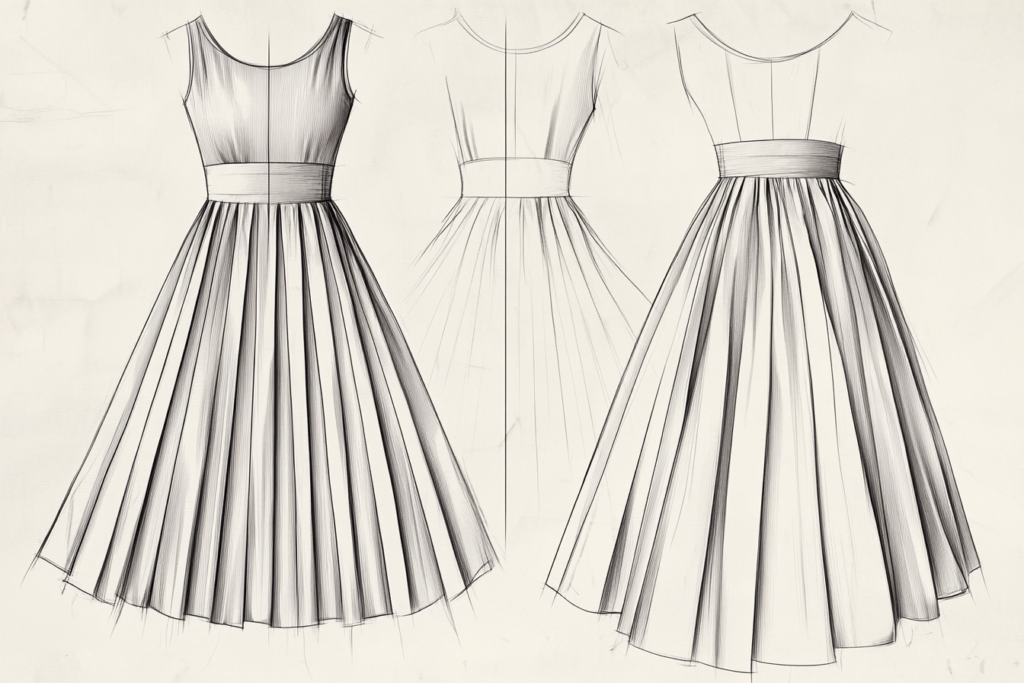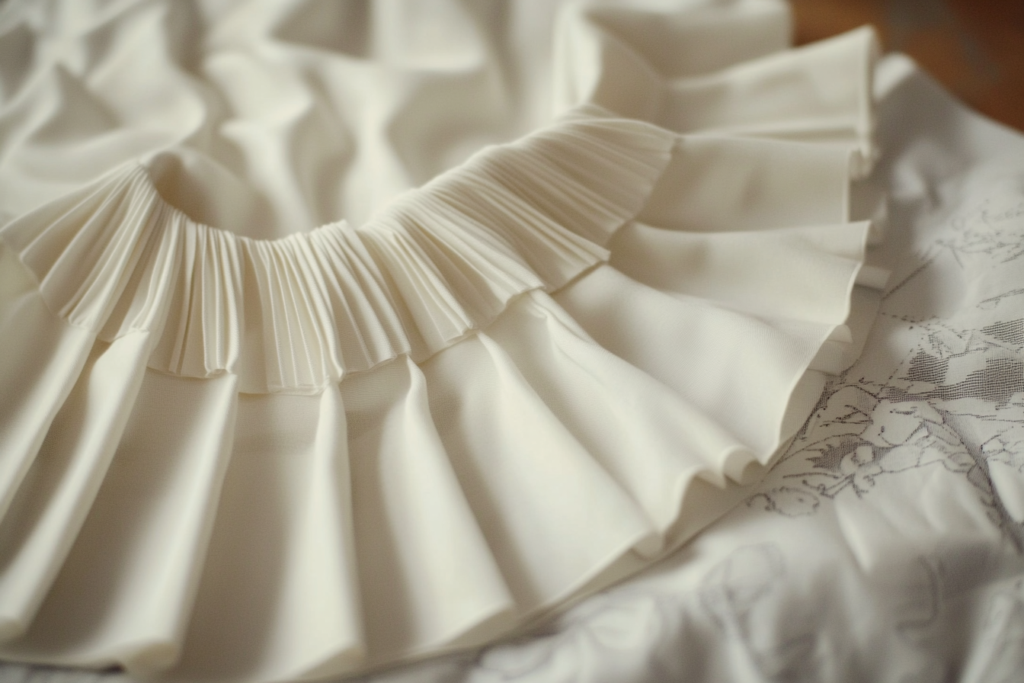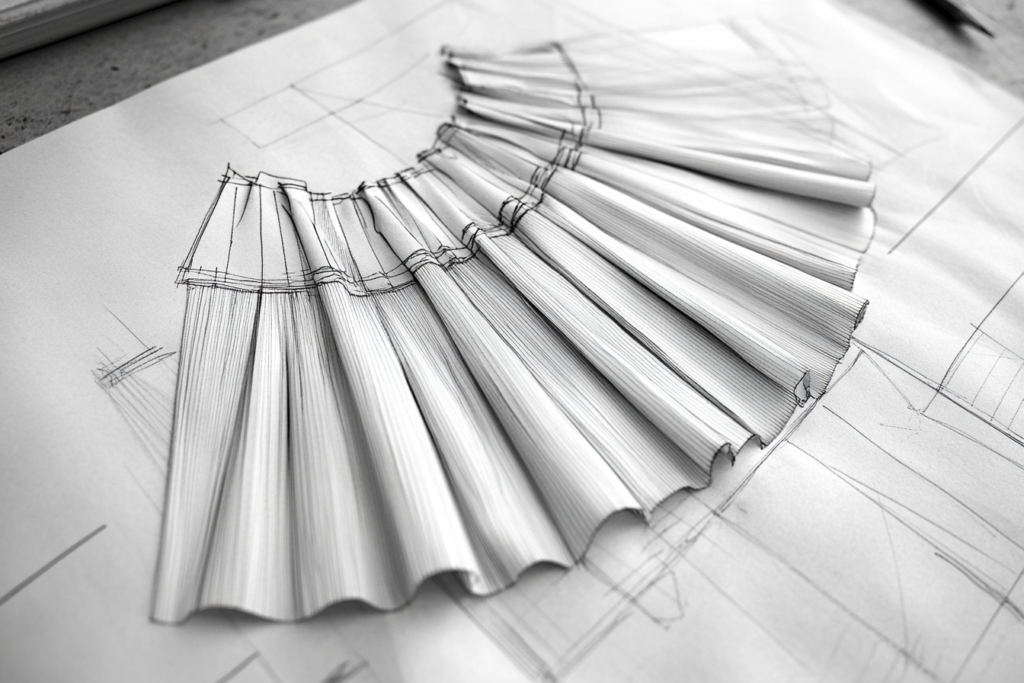Gathering: A Key Technique in Garment Construction
Meta Description: Gathering is a sewing technique used to create fullness in fabric by sewing a long edge to a shorter edge, forming pleats to make up the difference.
What is Gathering?
Gathering is a technique in garment construction that involves sewing the longer side of a fabric to a shorter side, creating pleats or folds in the process. This technique is often used when fabric needs to be manipulated to fit into a smaller area, like when attaching a skirt to a waistband or creating fullness in dresses, blouses, or even sleeves.
Gathering is done by stitching along the edge of the fabric and pulling the threads to bunch up the fabric into evenly spaced folds. The result is a gathered section of fabric that fits the shorter side or area. It’s an important technique used to create volume, texture, and shape in garments.


How Does Gathering Work?
To create a gathered effect, fabric is sewn with a basting stitch along the edge of the longer side. The steps involved in gathering are as follows:
- Baste the Fabric: A long, loose stitch (basting stitch) is sewn along the edge of the longer piece of fabric. The stitch length should be longer than usual to allow room for easy gathering.
- Pull the Threads: Once the basting stitch is completed, one of the threads is gently pulled to gather the fabric. The amount of gathering depends on how much fabric is being gathered and how tightly the thread is pulled.
- Even the Pleats: As you pull the thread, the fabric begins to gather into folds. These pleats should be evenly spaced along the fabric’s length.
- Sew the Gathered Fabric: Once the fabric is gathered to the desired amount, it is sewn in place, often to a smaller fabric piece (e.g., attaching a gathered skirt to a waistband).
Why is Gathering Used in Fashion?
Gathering is a versatile technique that adds volume and shape to garments, allowing designers and manufacturers to achieve a variety of effects, such as fullness at the waist, soft drape, or romantic flair in the design. It is especially useful in creating garments that need extra fabric or movement without adding a lot of bulk.
Key Reasons for Using Gathering:
- Creates Volume: Gathering adds fullness to a garment without the need for extra panels or wide hems. For example, A-line dresses, skirts, and blouses often use gathering to add volume to the lower part of the garment.
- Shaping: Gathering can shape fabric around curves, such as in bust or waist areas, allowing the garment to fit more comfortably while still maintaining structure and design.
- Decorative Effect: Gathered fabrics often have a textured, billowy appearance that adds a decorative effect to the garment. This is commonly seen in boho or vintage-inspired designs.
- Ease of Fit: Gathering can be used to reduce the size of a fabric piece to fit a smaller area. For example, a gathered neckline or sleeve cuff allows the fabric to fit snugly around the wearer’s body while maintaining a loose, comfortable look.
Common Uses of Gathering in Garments
- Skirts: Gathering is frequently used to add volume to skirts. A gathered skirt has a fuller look, especially when the fabric is attached to a waistband, giving it a flowing, feminine silhouette.
- Dresses: Dress designs often use gathering around the waist or bust to create shape and a more flattering fit. For example, a babydoll dress or a peasant dress typically uses gathering to add movement and volume to the garment.
- Sleeves: Gathering is commonly used to shape the sleeve caps on blouses and dresses. It gives the sleeve a puffed effect, adding extra dimension and style to the sleeve opening.
- Necklines: Gathered necklines are used to add texture and volume around the collar area, often found in casual or bohemian styles. This can help create a relaxed, easygoing look.
- Children’s Clothing: Gathered garments are frequently seen in children’s clothing because they create an airy, playful look. For example, gathered skirts or dresses often appear in kids’ fashion due to their comfort and charm.
Gathering vs. Pleating
While gathering and pleating both involve manipulating fabric to create texture, there are distinct differences between the two techniques:
| Gathering | Pleating |
|---|---|
| Involves sewing fabric into even folds by pulling thread along the edge. | Involves folding fabric in sharp, evenly spaced pleats and then sewing them into place. |
| The fabric is bunched together to create soft, flowing fullness. | Pleats create more defined, structured folds that lay flat. |
| Commonly used for skirts, dresses, or blouses where extra volume is needed. | Common in formal wear like pleated skirts, trousers, and dresses where structure is key. |
Tips for Perfect Gathering
- Choose the Right Fabric: Some fabrics gather better than others. Lightweight fabrics like cotton, silk, and chiffon gather beautifully, while heavier fabrics like wool and denim may be more challenging to gather evenly.
- Even Thread Tension: Keep the thread tension consistent while basting to ensure that the gathers are evenly spaced. Uneven tension can lead to irregular pleats or uneven fabric gathering.
- Ironing the Gathers: Once gathered and sewn in place, press the gathers lightly with an iron to help set them into the fabric. This will ensure they stay in place and maintain their shape.
- Adjust the Amount of Gather: If you’re aiming for a more subtle gathering effect, pull the threads gently. For more dramatic volume, pull the thread tighter to create denser, fuller gathers.
Conclusion: Gathering for Stylish, Flattering Designs
Gathering is a simple but effective technique used in garment construction to create volume, shape, and texture. It adds a feminine touch to garments like skirts, dresses, and blouses while ensuring a flattering and comfortable fit. Whether you’re designing casual, formal, or vintage-inspired fashion, mastering the art of gathering can elevate your creations and give them a beautifully tailored finish.



